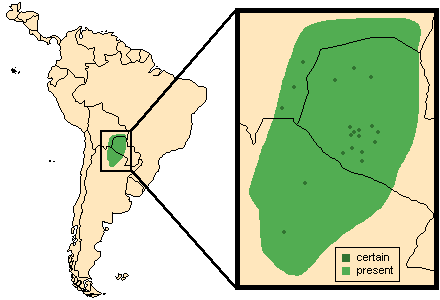![]() Return to
Artiodactyla
Return to
Artiodactyla
Classification
|
 Catagonus
wagneri
Catagonus
wagneri
Chacoan peccary
![]()
Taxonomy
 |
 |
 |
|
Click on the pictures above for a larger view of the
photographs
|
|||
General Characteristics
Body Length: 96-117 cm / 3.2-3.9 ft.
Shoulder Height: 52-69 cm / 1.7-2.3 ft.
Tail Length: 3-10 cm / 1.2-4 in.
Weight: 30-43 kg / 66-95 lb.The Chacoan peccary's bristly coat is a speckled charcoal or brownish-grey, interspersed with long guard hairs which may be up to 22 cm / 8.8 inches long. There is a whitish collar across the shoulders and under the chin, which is thinner and less distinct than that in the collared peccary. There is a black dorsal stripe which trails onto the tail. The head is extremely large, and the nose tapers to a snout disc made of cartilage. The long, donkey-like ears are covered with long, pale hair, as are the legs. The legs are relatively long and adapted for running, with dew claws only on the forelegs. The dorsal gland is prominent.
Ontogeny and Reproduction
Gestation Period: 5 months.
Young per Birth: 1-4
Sexual Maturity: Minimum breeding age is thought to be 3 years.Most births occur between September and November.
Ecology & Behavior
Most active during the late morning, the Chacoan peccary is primarily diurnal. During midday, they retire to the shadows of trees and bushes to rest. Chacoan peccaries frequently use dust baths and wallows. The distance vision and olfactory senses are well developed, although this peccary is not especially shy or wary. When frightened, Chacoan peccaries flee, raising the long hairs on their back and spraying secretions from their dorsal gland, presumably to keep the group together in the dense brush via odor. These secretions are rubbed against group members, and are also used as territorial markers. The population density is calculated to be 9.24 animals per square kilometer in favourable and protected areas.Family group: Solitary or in groups of 4-10 animals of all ages and sexes.
Diet: Cacti, roots, seed pods.
Main Predators: Puma, jaguar.
Distribution
Dry briars in Gran Chaco (northwest Argentina, northwest Paraguay, and southern Bolivia).

Range Map (Localities and approximate range redrawn from Taber, 1993)
Conservation Status
The Chacoan peccary is classified as endangered by the IUCN (1996).
Remarks
The largest peccary species, the Chacoan (pronounced "cha-KOE-in") peccary was first described by Rusconi in 1930. Surprisingly, this description was made from fossil remains and the peccary assumed extinct, until 1972 when Dr. Ralph Wetzel, on an expedition to the Gran Chaco, discovered three types of peccary recognized by the natives: the collared and white-lipped peccaries and a larger third species. Known locally as the tagua, this peccary is thought to be the most ancient, due to its small mental capacity and lack of adaptability.
Literature Cited
Nowak, R. M. [editor]. 1991. Walker's Mammals of the World (Fifth Edition). Baltimore: The Johns Hopkins University Press.Schmidt, C. R. 1990. Peccaries. In Grzimek's Encyclopedia of Mammals. Edited by S. P. Parker. New York: McGraw-Hill. Volume 5, pp. 48-55.
Taber, A. B. 1993. The Chacoan peccary (Catagonus wagneri). In Pigs, Peccaries and Hippos: Status Survey and Action Plan. Edited by W. L. R. Oliver. Gland, Switzerland: IUCN. Available online at http://iucn.org/themes/ssc/sgs/pphsg/Contents.htm
Wilson, D. E., and D. M. Reeder [editors]. 1993. Mammal Species of the World (Second Edition). Washington: Smithsonian Institution Press. Available online at http://nmnhwww.si.edu/msw/
Additional Resources
Wetzel, R. M., R. E. Dubos, R. L. Martin, and P. Myers. 1975. Catagonous, an "extinct"peccary, alive in Paraguay. Science, 189:379-381.
Return to Artiodactyla

![]()
© Brent Huffman, www.ultimateungulate.com |
|
|